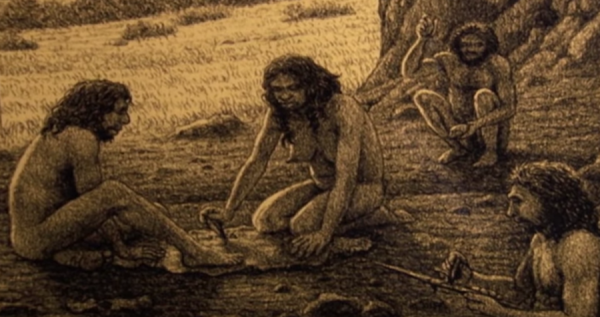By Vishal Goel, | April 08, 2017

Evidence of cannibalism, in the form of tooth marks, cut marks and tell-tale bone breakage has been found at a number of prehistoric sites. (YouTube)
According to a new study, cannibalism among early humans was more likely related to social reasons than just to satisfy hunger. Evidence of man-eating behavior at various sites also suggests the existence of ritualistic behavior. While arguing that human meat is much less nutritional than animals', scientists say that cannibalism could be more for ritual purposes than for survival.
Like Us on Facebook
Evidence of cannibalism, in the form of tooth marks, cut marks and tell-tale bone breakage has been found at some prehistoric sites, including in Spain, France, and Belgium, revealing that our ancestors as well as other hominins such as Neanderthals occasionally ate each other. But how common this practice was and to what extent it was driven by the need for nutrition has been a matter of debate. The new study adds weight to the idea that cannibalism might have been driven by something more than the necessity of hunger.
James Cole, an expert in human evolution from the University of Brighton, said that an adult male of about 66kg contains roughly 144,000 calories. But the nutritional value of many other animal species, whose remains were found at the sites, are higher. The muscles of a mammoth offered 3,600,000 calories, a horse 200,100 calories, and a red deer 163,680 calories. Cole added that this suggests that humans are not very nutritious and that humans are a fairly small animal who do not have much flesh and meat or fat to them.
The author of the research published in the journal Scientific Reports added that while smaller animals such as birds and hares were eaten by early hominins despite their low-calorie content, it would have been far more challenging to opt for cannibalism, as hominins can "fight, run and think their way out of the hunt."
Although Cole admits that the analysis is based on the nutritional value of a small group of modern male humans while Neanderthals were more muscular, he says that the research suggests cannibalism might have been driven by a complex range of motivations. "Maybe there is more of a social driver here, not ritual specifically, but social."
He suggests that among the possibilities, cannibalism might have been opportunistic with individuals being eaten when they died of natural causes, or that it might have been linked to territorial defence.
-
Use of Coronavirus Pandemic Drones Raises Privacy Concerns: Drones Spread Fear, Local Officials Say

-
Coronavirus Hampers The Delivery Of Lockheed Martin F-35 Stealth Fighters For 2020

-
Instagram Speeds Up Plans to Add Account Memorialization Feature Due to COVID-19 Deaths

-
NASA: Perseverance Plans to Bring 'Mars Rock' to Earth in 2031

-
600 Dead And 3,000 In The Hospital as Iranians Believed Drinking High-Concentrations of Alcohol Can Cure The Coronavirus

-
600 Dead And 3,000 In The Hospital as Iranians Believed Drinking High-Concentrations of Alcohol Can Cure The Coronavirus

-
COVID-19: Doctors, Nurses Use Virtual Reality to Learn New Skills in Treating Coronavirus Patients











